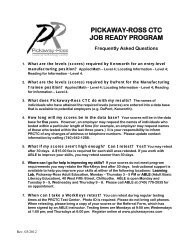Commons
Conceptual Physics - elearning-phys
Conceptual Physics - elearning-phys
- No tags were found...
Create successful ePaper yourself
Turn your PDF publications into a flip-book with our unique Google optimized e-Paper software.
13 How high above the surface of the earth should a rocket bein order to have 1/100 of its normal weight? Express your answer√in units of earth radii.14 As suggested on page 30, imagine that the mass of the electronrises and falls over time. (Since all electrons are identical, physicistsgenerally talk about “the electron” collectively, as in “the modernman wants more than just beer and sports.”) The idea is thatall electrons are increasing and decreasing their masses in unison,and at any given time, they’re all identical. They’re like a litterof puppies whose weights are all identical on any given day, butwho all change their weights in unison from one month to the next.Suppose you were the only person who knew about these small dayto-daychanges in the mass of the electron. Find a plan for violatingconservation of energy and getting rich.15 A typical balance like the ones used in school classes can beread to an accuracy of about plus or minus 0.1 grams, or 10 −4 kg.What if the laws of physics had been designed around a differentvalue of the speed of light? To make mass-energy equivalence detectablein example 15 on page 32 using an ordinary balance, wouldc have to be smaller than it is in our universe, or bigger? Find the√value of c for which the effect would be just barely detectable.16 (a) A free neutron (as opposed to a neutron bound into anatomic nucleus) is unstable, and decays radioactively into a proton,an electron, and a particle called an antineutrino, which fly off inthree different directions. The masses are as follows:neutronprotonelectronantineutrino1.67495 × 10 −27 kg1.67265 × 10 −27 kg0.00091 × 10 −27 kgnegligibleFind the energy released in the decay of a free neutron.(b) Neutrons and protons make up essentially all of the mass of theordinary matter around us. We observe that the universe around ushas no free neutrons, but lots of free protons (the nuclei of hydrogen,which is the element that 90% of the universe is made of). We findneutrons only inside nuclei along with other neutrons and protons,not on their own.If there are processes that can convert neutrons into protons, wemight imagine that there could also be proton-to-neutron conversions,and indeed such a process does occur sometimes in nucleithat contain both neutrons and protons: a proton can decay into aneutron, a positron, and a neutrino. A positron is a particle withthe same properties as an electron, except that its electrical chargeis positive (see chapter 5). A neutrino, like an antineutrino, hasnegligible mass.Although such a process can occur within a nucleus, explain why√Problems 37



